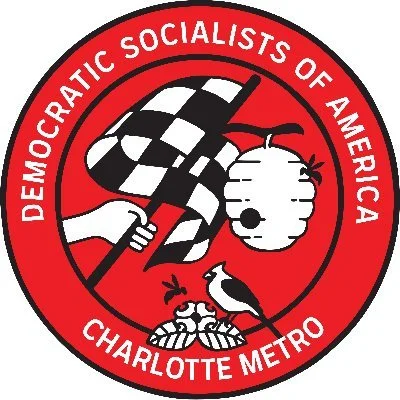

Jewish Traditions of Socialism W/ Rabbi Andy Bachman


Billionaires and Fascists: Blood Red Lines ft. Brendan O'Connor


From Protest To Politics - A Conversation about Bayard Rustin w/ John D'Emilio


The End of the World, As We Know It: Faith and Ecosocialism beyond Apocalypse


Socialism Uptown and DSA on the March
On Saturday, major news networks called the Presidential election for Joe Biden after it became clear he had won the State of Pennsylvania. New Yorkers took to the streets to celebrate the defeat of President Donald Trump as much as to celebrate Biden’s victory. On tonight’s show, we’ll talk with NYC-DSA co-chair Chi Anunwa about Saturday's march as well as DSA’s organizing strategy under a Biden administration.
We also have Ariadna Phillips from NYC-DSA’s Bronx Upper Manhattan Branch live with us to talk about DSA’s mutual aid work to feed South Bronx community members. The New York Times recently published an interview with Bronx and Queens congresswoman Alexandria Ocasio-Cortez after centrist democrats claimed leftist demands such as Medicare for All, a Green New Deal and defunding the police had caused the Democrats to lose races in swing states. We’ll talk with Ariadna about the necessity of such policies in her South Bronx community and more.
To support South Bronx Mutual Aid and Undocumented Women’s Fund by volunteering, donating, or requesting assistance, please click here:


North Carolina Demands that Every Vote be Counted!
Trump and the Far Right are doing everything they can to subvert the will of the people. We must be prepared to fight any effort to subvert the democratic will of the working class. We cannot allow the Republican party to disenfranchise people with the same Jim Crow playbook they've been using for generations in order to continue their deadly authoritarian agenda on every level of government.
Sign the pledge now to show your support for counting every vote and are willing to mobilize if any attempts are made to steal the election. Add your name now to pledge your commitment to take action to ensure that every vote is counted.
No matter what happens, we will continue to fight for democracy, Medicare for All, a Green New Deal, and more. A better world is possible.
The Democratic Socialist of America Chapters of North Carolina
Asheville DSA
Charlotte Metro DSA
Greensboro DSA
Piedmont DSA
Wilmington DSA
Winston Salem DSA


The Void: 2020 Election Recap


BCPD Car Displays Disturbing Thin Blue Line Punisher Logo

Two weeks ago passersby observed a BCPD patrol car parked outside of Hotel Boston. By itself this is not newsworthy. The school is using the hotel to quarantine students. It was the image displayed on the car’s computer screen that is cause for alarm. The onlookers were taken aback by the thin blue line Punisher skull logo visible for all to see.
This is alarming for a number of reasons. Blue lives matter is a reactionary message created specifically in opposition to the Black Lives Matter movement. The thin blue line “is a term that typically refers to the concept of the police as the line which keeps society from descending into violent chaos.” The thin blue line flag is a black and white version of the American flag with a blue line running through the middle. The combination of these symbols with the Punisher skull logo is extremely problematic.

Across the country military and police have embraced this symbol in recent years. The co-creator of the Punisher Gary Conway has pushed back against this appropriation and strenuously rejected any connections between his creation and law enforcement and white supremacy. Officers in a number of departments have been investigated or disciplined for using the symbol on uniforms or police vehicles. It should also be noted that in 2018 BCPD officers mocked the Black Lives Matter slogan during an incident with two students.
On its own, the blue lives matter message is cause for concern. There is no such thing as blue lives. Blue lives matter is a movement that developed in response and in opposition to the Black lives matter movement. Black lives matter is anti-racist. It began in response to the continued murder of Black people by police in America. Quite literally it simply affirms the most basic idea that Black lives actually do matter. That any group would not simply affirm and support this idea, and instead feel the need to counter it is revealing. If police are offended at the notion that Black lives do matter or have a problem with people protesting racism and the murders of Black Americans by police then they are revealing a great deal about their attitudes and beliefs.
The blue lives matter message has not only been propagated by police. Donald Trump has increasingly embraced the logo as part of his racist law and order messaging in recent weeks. He called the Black Lives Matter slogan a painted on a street in New York City a “symbol of hate.” He routinely tells white women voters Democrats will bring low income housing to the suburbs and that American cities and police are under attack by Antifa and Black Lives Matter activists.

Brooklyn public defender Scott Hechinger wrote of Trump’s embrace of the flag “There are few things as ominous to me as the Thin Blue Line flag. It’s not about ‘supporting police.’ It is a worship of power, oppression, & violence. It is the privilege of wanting to perpetuate racist, brutal state control over Black & brown people. It is also anti-American.”

It has also been embraced by white supremacist groups and been displayed at places like Charlottesville in 2017. As USA Today reported “A black-and-white American flag with a thin blue line across its center appeared among the Confederate flags toted by the white supremacists and neo-Nazis during the violent protests.”

At a flea market in Pennsylvania last month a vendor sold Blue lives matter flags next to Confederate and Nazi flags.

The blue lives matter Punisher logo represents an even more disturbing idea. The Punisher character first appeared in 1974. He is a vigilante who uses violence, torture, and murder to extract revenge on his enemies. Instead of upholding the law he acts as the judge, jury, and executioner. He has killed more people than any Marvel character in the comic book company’s history, killing 48,502 people since his introduction 46 years ago. From George Floyd to Breonna Taylor to Eric Garner and the endless list of Black people killed by police it is clear why the embrace of this symbol by police is so disturbing, especially as it has grown in prominence at the exact moment that people across the country are demanding an end to police violence and to these murders.
Joseph Darda, an English professor at Texas Christian University explained “If you look at the 200 year history of U.S. policing, it becomes apparent that every time white people turn to a defense of police and start associating their identities with police, it’s often occurring at the same time as heightened Black activism.” He continued “This idea of ‘blueness’ is a thin veil to throw over one’s white racial interest. It’s a convenient deniability if you don’t want to be lumped in with the David Dukes of the world.”
The co-creator of the Punisher logo Gary Conway is a vocal critic of the embrace of this image by police. In September of this year he bluntly stated “Said it before, say it again: Wearing a ‘Punisher’ skull symbol on a police uniform or vehicle should be cause for immediate dismissal of the officer. Ditto for any symbol that’s come to represent white supremacy. In an interview in July of 2019 Conway compared the use of the symbol by police to putting a Confederate flag on a government building.
Conway went further than just objecting to law enforcement’s adoption of the logo. He set out to partner with comic book artists of color to raise money for Black Lives Matter and “reclaim the Punisher skull as a symbol of justice rather than lawless police oppression.”

Conway did not mince words about the link between racism and law enforcement’s embrace of the Punisher logo.
“For too long, symbols associated with a character I co-created have been co-opted by forces of oppression and to intimidate black Americans. This character and symbol was never intended as a symbol of oppression. This is a symbol of a systematic failure of equal justice. It’s time to claim this symbol for the cause of equal justice and Black Lives Matter.”
Comic book artists submitted dozens of designs helping raise over $70,000 for Black Lives Matter Los Angeles.
The writers at Marvel disapprove of police’s use of the logo as well. In July 2019’s The Punisher #13 the Punisher, Frank Castle, encounters two NYPD officers. The officers tell Castle how much they admire him, ask to take cell phone pictures with him, and show him the Punisher logo they placed on their squad car. To their surprise Castle rejects their adulation and rips the logo off the car and tears it to shreds.

In 2019 22 officers in St. Louis were investigated for posting racist messages on facebook. The city’s Circuit Attorney Kimberly Gardner moved to block the officers from submitting cases to her office due to their conduct. In response to officers facing consequences for posting racist messages, the head of the St. Louis police union Ed Clark defended the officers and called other officers to make the thin blue line Punisher logo their profile picture in a show of solidarity. In a facebook post Clark wrote:
“The fact is, there will always be someone who finds fault with any symbol we identify with or person we choose to carry our message. The Blue Line symbol and the Blue Line Punisher symbol have been widely embraced by the law enforcement community as a symbol for the war against those who hate law enforcement. It’s how we show the world that we hold the line between good and evil.”

The fact Clark would defend officers for posting racist messages is alarming. The fact that his response to this is to call on officers to embrace the Punisher logo and declare that police are at war with those who hate them is deeply disturbing. Everything about this mentality and the embrace of the logo should frighten us.

In October 2019 the Dallas Community Police Oversight Board met for the first time. As Gizmodo reported tensions flared when the board attempted to end the meeting without letting members of the public speak. Confrontations broke out between police and audience members, and news footage shows one officer wearing a Dallas PD hat with a Punisher logo stitched onto the back confronting a Black elected official.

The Dallas police told reporters that “Internal Affairs Unit is actively investigating this incident as a violation of the uniform policy, General Order 802.1.” Because the logo was embroidered on the hat, it raised questions whether it was custom made by the officer or issued by the department.
In response to the incident in Dallas Gary Conway reiterated his objection to law enforcement’s use of the logo, tweeting “Any ‘cop’ who wears a Punisher logo in his official capacity is identifying law enforcement with an outlaw. These ‘cops’ are a disgrace to serious police officers everywhere. They show an imbecilic level of irresponsibility and should be fired immediately.”
In September of this year a Toronto officer was observed wearing a Punisher skull logo patch on his uniform emblazoned with the words “Make no mistake, I am the sheepdog.” Toronto police spokesperson Meaghan Gray told the Toronto Star “The officer wearing the patch has been identified and he has been directed to remove it immediately.” She continued “It is not approved, nor appropriate, for him to be wearing it on his uniform. This is now a matter of internal discipline, and as a result I am unable to offer anything further.”
The entire ideology behind blue lives matter, the thin blue line, and the use of the Punisher logo by police is problematic. There is a clear hostility on the part of many in law enforcement to the Black Lives Matter movement or to any accountability for police violence towards the Black community. The embrace of these symbols and ideologies is indicative of a belief in an us versus them mentality where police see themselves as vigilantes dispensing justice against hostile members of society. The violent and often times out of control response by police to peaceful protests over the summer in response to the murder of George Floyd, Breonna Taylor, and others is indicative of this mentality. At the same time though they also uphold themselves as victims. In August 2017 a New York City police union put out a video on blue racism.
“The average person doesn’t see those things that make me human. They don’t even label me based on being African American, Latino, Asian, Caucasian, and so on. They tend to see an even broader stereotype through an even more racist lens. When they look at me, they see blue.”
The absurd idea that blue racism exists and is worse than racism against Black Americans is too idiotic to take seriously. But this is what one of the largest police unions in the country is propagating.
The hostility to Black Lives Matter and embrace of vigilantism and violence represented by the blue line Punisher logo is not simply an academic concern. Just this week The Guardian reported that in the last five months there has been 950 acts of police brutality against civilians and journalists during anti-racism protests sweeping the United States. At the same time police have been friendly or accommodating to racist alt-right or right-wing extremists who come to counter protest and oppose Black Lives Matter protests. “Nineteen incidents show police being permissive to far-right members and treating white supremacists favorably at protests.”

Alexander Reid Ross, a professor at Portland State University and researcher at the Center for Analysis of the Radical Right stated “This is vigilante activity, that the anti-Black Lives Matter protesters believe is an extension of police – and in some cases the police agree… It’s sort of one hand washes the other here, where the police are unable to come in and beat down the protesters in this way sometimes, and so the far right, which absolutely supports the police, does it for them.”
In discussing the symbol in displayed by BCPD it is relevant to point out this is the same BC police department whose officers mocked the Black Lives Matter slogan back in 2018. When Climate Justice Boston College members Mathew Barad and James Mazareas were detained by BCPD in March of that year for writing in sidewalk chalk as part of a free speech protest, an officer retorted “all lives matter” upon seeing “Black Lives Matter” written on the ground. Barad described the incident in an article.

BCPD is run by former Boston Police Chief Bill Evans. Evans collaborated with ICE during his tenure as chief as his department cooperated and shared data with ICE helping the agency track down and detain immigrant residents. His department also engaged in racially discriminatory policing against Black and brown residents and maintained a racially biased gang database. In 2016 Black residents made up 70% of stops, interrogations, and observations by police despite accounting for only 25% of Boston’s population. This was actually an increase over the 63% of encounters that involved Black residents from 2007 to 2010. As the diagram below reveals Boston Police target the city’s Black and brown neighborhoods over other areas of the city.

Just this past summer, on the same day that Father Leahy sent an email to the entire BC community asking members to pray for George Floyd, BCPD sent it’s officers to a Black Lives Matter protest in Dorchester’s Franklin Park to police a protest against his murder. Evans actually defended this outrageous decision in a statement to The Gavel.

The use of this logo by BCPD is unacceptable. It is not just the appearance of the logo that is concerning. It is what the image represents, the beliefs and ideology behind it that have been embraced by law enforcement across the country. How many BCPD officers share in these beliefs? How widespread is the use of this imagery by BCPD? Is this image loaded onto multiple computers in the department? What other imagery do BC officers embrace? Since officers share patrol vehicles it’s hard to believe this is something multiple members are not aware of, especially since it is visible in plain view to those outside the vehicle. Does BCPD feel like police officers are at war with those who hate them? Do they agree with the head of the St. Louis police union who said the blue line and blue line Punisher logo have been widely embraced by the law enforcement community as symbols of that war? Does BCPD feel they are disrespected by the public or BC community or that that blue racism is real and worse than other forms of racism? In light of BCPD’s use of this image these are all legitimate questions that need to be answered by Boston College and by the Boston College Police Department.


Local DSA Members Debut Equal Time Radio (the Podcast)
Looking for an in-depth analysis of current events in Vermont and nationally, from a Left and Labor perspective? Check out Equal Time Radio with DSA member Traven Leyshon. Equal Time began as a progressive initiative driven by State Senator Anthony Pollina back in 2007, who saw the lack of a strong Leftist analysis of Vermont news and its relationship to the larger national context. Traven, the current host, joined the team shortly thereafter and is a longtime labor activist and Vermonter who is the current president of the Green Mountain Labor Council. This past summer, Traven teamed up with DSA members Dayna Stimson and Anthony Apodaca to transform the weekly radio show into a podcast format.
Equal Time strives to bring greater attention to issues often ignored by the corporate media: working class struggle, the climate crisis, Black liberation, and economic justice, among many important topics. Broadcast weekly, the show has featured writers from Jacobin, Labor Notes, the Economic Policy Institute, DSA, Rights & Democracy, Vermont Workers Center, and Vermont Public Assets, among others. Featured guests include Stephanie Yu, Paul Cillo, Daniel Denvir, Let’s Grow Kids, Bhaskar Sunkara, Alex Vitale, Howie Hawkins, Jill Stein, and David Zuckerman. Traven uses his extensive experience as a Leftist to bring greater insight and understanding to the issues currently facing us, as he talks to the people shaping the movement locally and nationally.
Listen and subscribe to Equal Time Radio on Apple Podcasts, Spotify, or Stitcher. You can also subscribe to our newsletter to make sure that you never miss an episode release! Learn more at equaltimeradio.transistor.fm.


